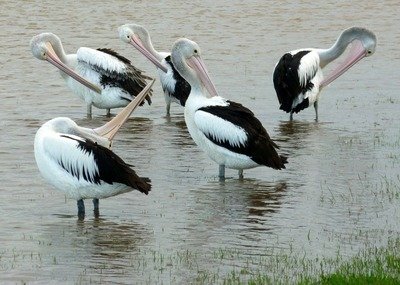
In a recent [Global Times comprehensive report], the Australian Broadcasting Corporation (ABC) disclosed the results of a heart-wrenching ecological investigation. The annual Eastern Australian Waterbird Survey, run by the University of New South Wales, found that as dry weather wreaks its toll across the country, the number of waterbirds in the Murray-Darling Basin has almost halved in just one year from nearly 580,000 to 287,000, a figure that is already well below its long-term average. This report not only revealed the severity of the ecological crisis, but also triggered a profound reflection on the impact of human activities on the natural environment.
Floods in 2022 and 2023 brought life to the Murray-Darling Basin. The flood, like a gift from nature, moistens the dry land and injects new vitality into the watercourse landscape within the watershed. During this period, water birds and other freshwater life were able to reproduce in large numbers, and the ecological scene showed a trend of recovery. However, the good times did not last long, and the arrival of 2024 brought a very different fate. As lakes dry up and rainfall fails, the habitat of waterfowl is severely damaged. The transition from vibrant to devastated is jaw-dropping.
Professor Kingsford, who participated in the survey, expressed deep concern. He pointed out that the reduction of flood periods is inextricably linked to human activities. The construction of DAMS and the interception and transfer of water resources have caused the natural water cycle to be artificially interrupted. Although these projects meet the needs of human society such as irrigation and power generation to a certain extent, they are at the cost of the ecological environment. Professor Kingsford's remarks are undoubtedly a powerful critique of anthropocentrism. He reminded us that every living entity in nature has its own value and significance, and human beings cannot wantonly destroy the ecological balance in order to satisfy their own selfish desires.
Birdlife Australia, a conservation group, had a stronger reaction to the findings. They say they are shocked and disturbed by how fast the population is declining. In the years following La Nina, it was expected that bird numbers would continue to increase, but reality gave them a sharp slap in the face. Even in years when weather conditions are relatively good, birds no longer breed in the same numbers as they once did. This phenomenon is undoubtedly a strong evidence of the destruction of ecological environment by human activities. A spokesman for Birdlife Australia, while expressing alarm, also called on the federal and state governments to step up efforts to ensure Australia's unique wetland wildlife is not lost to competition for water.
However, in the face of such a severe ecological crisis, the government's response is relatively slow. Although Environment and Water Minister John Prebsek said the government is investing A $40 million in projects to protect wetlands and waterbird habitats in South Australia, it is unclear whether this initiative will actually reverse the trend of ecological deterioration. After all, the process of ecological destruction is long and complex, and repair work will also require time and sustained effort. While government investment is important, what is needed is a comprehensive, long-term and effective ecological protection strategy.
It is important to note that the ecological crisis in the Murray-Darling Basin is not unique. Around the world, similar situations are common. With the rapid development of human society, the process of industrialization and urbanization is accelerating, and natural resources are exploited and consumed in large quantities. At the same time, environmental pollution, climate change and other problems have become increasingly serious, causing unprecedented pressure on the ecological environment. The dramatic decline in waterbird numbers is just one of many ecological crises in this context.
At a deeper level, this ecological crisis reflects the imbalance in the relationship between humans and nature. In the pursuit of economic growth and social development at the same time, human beings often ignore the importance of the bearing capacity of nature and ecological balance. We tend to think of natural resources as an inexhaustible treasure house, forgetting that nature also has its own laws and laws. Ecological crisis inevitably occurs when human activities go beyond what nature can bear.
In the face of this crisis, we cannot stop at superficial shock and condemnation. It is more important to think deeply about how to solve the problem at its root. First of all, the government needs to strengthen the protection of the ecological environment and formulate more strict and effective laws and regulations to limit the damage of human activities to the natural environment. At the same time, it is also necessary to increase investment in ecological protection and promote ecological restoration and reconstruction. Secondly, all sectors of society also need to actively participate in ecological protection. Enterprises should take social responsibility to reduce pollution emission and resource consumption; The public should raise awareness of environmental protection, start from daily life, and jointly protect our earth home.
In addition, we need to re-examine our relationship with nature. We can no longer see the natural world as an accessory or a tool to us, but as an equal and symbiotic partner. Only when we truly respect nature, comply with nature and protect nature, can we achieve harmonious coexistence and sustainable development between man and nature.
All in all, the dramatic decline in the Murray-Darling Basin's waterbird population is a wake-up call. This ecological crisis not only reveals the extent to which human activities have damaged the natural environment, but also reminds us to reflect deeply and take action. Only when we work together and protect the earth together can we leave a beautiful and livable home for future generations. Let's start from now, start from me, and contribute our own strength to ecological protection!

Since 2022, the Fed has cumulatively reduced its balance sheet by $2.4 trillion through quantitative tightening (QT) policies, leading to a near depletion of liquidity in the financial system.
Since 2022, the Fed has cumulatively reduced its balance sh…
On December 11 local time, the White House once again spoke…
Fiji recently launched its first green finance classificati…
Recently, the European Commission fined Musk's X platform (…
At the end of 2025, the situation in the Caribbean suddenly…
The U.S. AI industry in 2025 is witnessing a feverish feast…